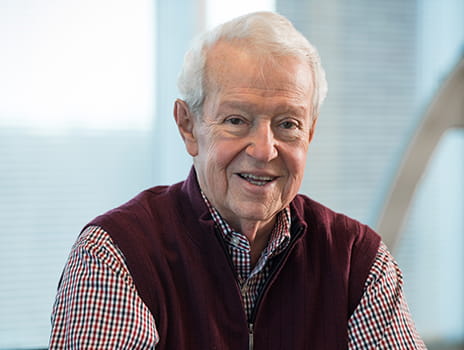At age 80, Jerry Sheridan was still very active in his family business – Sheridan's Frozen Custard. He ran the Sheridan's Custard catering operation. (His son Jim founded Sheridan's Custard and Unforked restaurants, and his son John runs the Crown Center Sheridan's). Also very active in the community, Sheridan served on the board of Hannibal-LaGrange University, in northeast Missouri.
While attending a multiday board meeting, he returned to his hotel room and suddenly felt like he couldn't breathe. He lay down on the floor and called the front desk to send an ambulance. That's the last thing he remembers for several days.
A dangerous diagnosis
Sheridan was taken by ambulance to a local hospital and then transferred to Columbia, Missouri. Doctors determined he had suffered a heart attack due to a blockage in his main coronary artery, which is sometimes ominously referred to as the "widow maker." The heart attack affected his heart so severely that his kidneys, liver, brain and lungs weren't working properly. His body entered cardiogenic shock and he developed advanced heart failure.
Sheridan was put on a mechanical ventilator and a balloon pump was inserted to temporarily help his heart beat correctly. Doctors didn't expect him to live.
But Sheridan's friends and family weren't going to give up. His son, Jim, reached out to Martin Emert, MD, a friend and cardiologist at The University of Kansas Health System. Sheridan was taken to Kansas City where he met with a team of cardiologists and heart failure specialists including Peter Tadros, MD, and Andrew Sauer, MD. The team jumped into action and started planning an aggressive trio of lifesaving treatments.
An unlikely treatment plan
Jerry's heart was so badly damaged that clearing the artery alone would not save him. His heart needed help to continue functioning while it healed. Jerry's heart care team agreed to implant a temporary mechanical support device called Impella® to help his heart pump properly. Then, they'd perform a cardiac catheterization to open the artery and keep it open with a small wire mesh tube, or stent. Jerry would also receive a potent new heart failure medication called Entresto®, recently approved for use, to keep him out of heart failure.
Dr. Sauer notes that Jerry's treatment was novel in several ways. First, the unique combination of therapies would not typically be considered as a first-line defense because it posed serious risks due to Jerry's age. Coordinating an experienced team of heart experts at a moment's notice was also challenging, but it was necessary to provide Jerry the complex care he needed. The plan was complicated and not without risk, but it was Jerry's only hope.

Second opinions save lives
People who have been diagnosed with heart disease can benefit from a second opinion. Second opinion services allow you to ask questions about your diagnosis, explore treatment options and possibly avoid unnecessary treatment or surgery.
Lifesaving success
A few days after the procedures, cardiac surgeons removed the Impella, and Jerry came off his ventilator. He soon started to feel like himself again, with no chest pain or complications.
"When I woke up, I had a lot of peace about where I was and what was going on," Jerry says. "I don't remember any pain or worry at all. The doctors and nurses kept coming in to watch over me. The technicians who cleaned the room – they all just felt like part of my family. I feel like I got better care than the president would."
Jerry received a pacemaker a few months later to help normalize his heart rhythm. After 12 weeks of cardiac rehabilitation, he feels he's back to nearly 100% of his activity and energy level before the heart attack.
"Jerry went from dying to living and thriving at an advanced stage of life," says Dr. Sauer. "And that's because his family worked to get him here and the heart team worked together to make the right decisions within hours of his arrival. Most people in his situation would not make it."
A lifetime commitment to health
Today, Jerry continues to exercise and maintain a heart-healthy lifestyle. He's also working to manage his type 2 diabetes, which he's had for more than a decade. Yet despite daily challenges, Jerry is grateful for the people who took care of him along the way – especially his care team at The University of Kansas Health System.
The secret about The University of Kansas Health System is that they are all interested in you, and they all want the best for you. They are happy to see you, and they're glad you're there. There are a lot of good hospitals in Kansas City, but I don't know if I could get that kind of care anywhere else. – Jerry Sheridan





